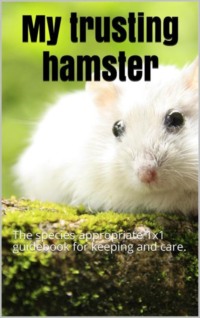Kitabı oku: «My trusting hamster», sayfa 2
Djungarian Dwarf Hamster
It is also called short-tail dwarf hamster, a subspecies is the Campbell dwarf hamster, that shows big similarities in the look.
Color: ash gray, light brown, dark brown
Weight: 19-45 g, fluctuates in the annual rhythm
Origin: steppes of northeastern Kazakhstan and southwestern Siberia, large parts of Mongolia
Special features: Color change in the course of his life
Features: very intelligent
Life expectancy: 2-3 years
Breed characteristics: 70-105 mm length, tail length 8-18 mm, dark eyes, summer coat: ash gray to light brown, black-brown eel line, from head to tail, underside of the coat is whitish The border to the fur at the upper side is recognizable at the body-sides in 3 bows. Fur-change in the winter: partially or completely whitish.
The Dsungarian dwarf hamster has short, powerful extremities and small claws. Also its cheek-bags, where it can store food collected at short notice, are distinctive.
Gold hamster
This hamster is also called Syrian hamster.
Colors: golden-white
Weight: 90-150 g
Origin: Middle East, today still in the border area between Syria and Turkey, Aleppo Plateau
Life expectancy: max.4 years
Special features: robust, aggressive towards conspecifics
Breed characteristics: Back is gold-colored, belly is white, on the cheeks are dark stripes, the typical loner, also in the wild the animals meet only during the mating season, 15-19 cm long, tail length 1-1,5 cm, rodent teeth grow constantly, therefore constant gnawing necessary;
Spotted golden hamster
This hamster-type is also called 3-colored gold-hamster.
Colors: different variations with white spots
Weight: 80-150 g
Origin: Middle East, border region between Turkey and Syria
Characteristics: much more nervous than their conspecifics, less fast and more difficult to tame
Special features: more susceptible to diseases, more aggressive against conspecifics
Life expectancy: 1.5-2 years
In the physique, the 3-colored gold-hamster is approximately same with the classic gold-hamster, it has other fur-colors and race-specific peculiarities, however.
The attitude and taming of this race required much calmness and patience! The Scheckung arose first through the natural mating of different colored gold-hamsters in the wild, through aimed crossbreeding, the breeding of the animals developed. Today the symmetrical 3-colored variant has become generally accepted. The panda hamster is also popular, its fur resembles the coat pattern of a panda bear. Another breeding form of the gold-hamster is the satin hamster.
Its peculiarity lies in its silky shining fur. The hairs are hollow inside, the sunlight can therefore shine through and create the beautiful shine. Also the snail hamster is a breeding form of the golden hamster. It is multicolored, "colorful", its immune system is not considered to be very robust and it is rather prone to disease.
Teddyhamster
This hamster is also called Angora Hamster, is a long-haired golden hamster and is one of the most popular hamster breeds.
Colors: all
Weight: 100-200 g
Origin: Syria
Characteristics: long coat
Characteristics: trustful, individual, can be happy about returning owner
Life expectancy: 2-3 years
Breed characteristics: 15/16 cm long, physique is very similar to that of the classic golden hamsters, long, soft fur hairs, especially recognizable on the back part of the animal, males have longer hairs than females, fur needs special care because it tangles easily, bath sand in the cage is essential
It should be noted that the animals prepare for hibernation below 8 degrees Celsius. This leads to a slowing down of the heartbeat and a reduction of the body temperature.
This forced hibernation should never be forced intentionally, it is not necessary when keeping the hamster indoors and only costs the hamster unnecessary energy. Many owners mistakenly believe that their animal has died in this state.
Ücretsiz ön izlemeyi tamamladınız.
